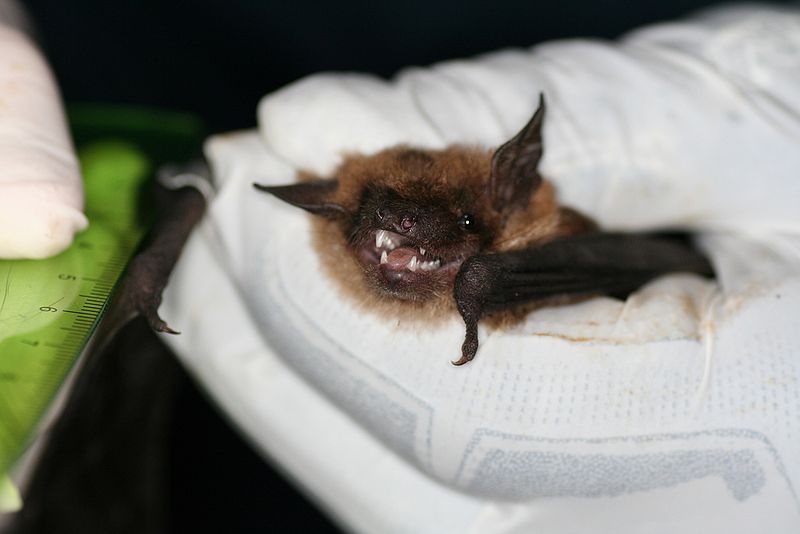
Last week was National Pollinator Week. Did you eat your pollinator cake and enjoy pin-the-tail-on-the-pollinator games at your neighborhood pollinator party? Yeah, me neither. But, thanks to an observant friend who’s on a lot of e-mail lists, I did get to celebrate with a bat walk.
Some bats are pollinators. None of them happen to live here in Washington, D.C. Pollinating is more of a thing for bats that live in the tropics and the desert. But our local bats are, like many bats, cute and fuzzy as heck, so I will not complain that the U.S. Department of Agriculture hosted a bat guy as part of their eighth annual Pollinator Week Festival.
We met on a street corner at 8 p.m., next to the U.S. Department of Agriculture. The bat guy – Rob Mies, founder of a bat conservation organization in Michigan – had brought a big brown bat with him, in a cage. Apparently the best way to tell the difference between a lot of bat species, including the big brown bat, is to do a bunch of careful measurements and maybe check their DNA. I was glad to find out the easy way: being told by an enthusiastic man in an adorable bat t-shirt.
While he held the bat in his gloved hand and fed it mealworms, I learned bat facts:
- Bats kind of look like mice with wings, but they aren’t rodents, and aren’t even particularly closely related to them. They’re their own thing: chiropterans.
- The glove is to protect the bat, not the human.
- Apparently sometimes bats don’t mind it when you stretch out one of their wings to show an audience, but this bat was having none of it.
- Related fact: Bats do sometimes make sounds that are audible by humans.
- If you ever get a bat in your house, close the doors to the rest of the house and open a door or window to the outside. Then stand by a wall. Bats need to swoop when they fly, so if you stand in the middle of the room you’ll be like, “augh why is this bat attacking me” when it’s really just trying to get out.
- Bats look funny when they eat mealworms. There’s a lot of snarfing.
- Brown bats mate in the fall but the females don’t get pregnant until spring.
- They store the sperm all winter!
- How cool is that?!?
- Bats will not eat fireflies. Also, if you mix fireflies in with mealworms, then take the fireflies away, the bats will still be like “UGH” and refuse to eat the mealworms. Bats are no dummies.
- A female brown bat will catch thousands of insects a night to make enough milk for her baby.

The bat guy led us across the street, to the double row of majestic trees that lines the edge of the National Mall. The first time he came, a few years ago, he told us, he thought: there are insects here and that’s a great fly-through; this is a place for bats. I can confirm the part about the insects. The mosquitoes feasted on my legs. He pointed his bat detector at the sky and we waited for the sun to set.
The bat detector is a microphone that works at super high frequencies and plugs into an iPad. The local bats use echolocation to find insects to eat, sending out squeaks and listening for them to come back. We can’t hear those sounds, because they’re so high-pitched, but software on the iPad can modulate them and play them instantly at a frequency that we can hear. The software also checks bat sounds against its database and tells you what species is flying over. If you want one–you want one, right?–you can get the professional version for $349, or a version for the casual bat enthusiast for $179. It’s red. So cheerful.
More bat facts were shared:
- If a flying thing at night goes flap flap flap flap gliiide, it’s a bird.
- If it goes FLAPPITY FLAPPITY FLAPPITY with no gliding, it might be a bat.
- Nets for catching bats (for science) need to have skinny threads, because bats are really good at detecting them. But, if the threads are too skinny, they can’t stand up to a big owl. Say goodbye to your several-hundred-dollar net.
We wandered along the avenue of trees. We were right there on the National Mall, across from the Smithsonian’s National Museum of American History, but could see almost none of the buildings that are in the news. The Capitol hid behind trees. The White House is only ever visible if you’re directly north or south of it, and we were off to the east. As the sun went down and the flapping overhead continued to be birds, the fireflies came out. Slowly, so slowly, their green lights rose from the green grass, a sparkling fairy carpet under the trees.
A little before nine, the iPad bleeped—a bat! A few people saw it fly past, but I missed it. Another zipped over 10 minutes later, then another after that. They were all in a hurry, though. None hung around to forage. The hawk that kept swooping over us might have had something to do with this.
Around 9:15, we gave up and wandered back. The female brown bats are out foraging alone for now, the bat guy told us. In a few weeks, if we’re looking in the right place, we’ll see pairs of bats, mama and baby. Maybe threes, if there are twins. The babies will learn to catch moths and mosquitoes for themselves. They’ll whirl through the Lincoln and Jefferson Memorials, snapping up bugs and flying on before a predator catches on. They’ll get fat and mate, go spend the winter in a cave or a mine somewhere, and come back next spring to start again.
Photo: Helen Fields (Washington Monument); U.S. Fish & Wildlife Service Northeast Region (bat)
I’ve signed up for a bat walk in Central Park in August, and I’m looking forward to it even more after reading your post.